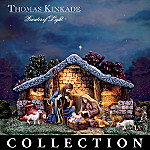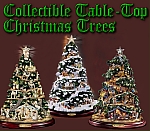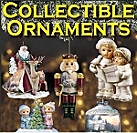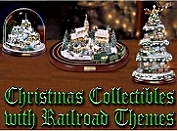| Written by Paul Race for Family Christmas OnlineTM |
In Search of Baby JesusWhen I was a child, our church had three Jesuses. There was "Big Jesus" who had mournful blue eyes and a forked beard. There was the "Christ Child" (Kristkinder in German) who was about 5, wore a crown, and held a globe. And there was "Baby Jesus," who appeared once a year in the manger at church and at home.The nuns weren't particular which Jesus we prayed to. In fact, when I was little, adults seemed to think my sisters and I would relate best to Baby Jesus. "Ask Baby Jesus to help you feel better." "Ask Baby Jesus to help you on the test." And so on. As I grew older, I realized that praying to Baby Jesus wasn't universal, but at the time, it seemed quite normal.
Fifty-plus years later, my parents are gone, and our nuclear family has their own nativity and traditions. Mom and Dad's nativity has gone to a niece, the oldest child of my oldest sibling. And our family sets up the set that my sister Tess gave us when our kids were little. But when I was researching nativities for other articles on the FamilyChristmasOnline.com site, I couldn't help breathing a little nostalgic sigh whenever I'd come across pieces from the set I grew up with. Now I know that what we had was the "least of these" as far as many family nativity sets were concerned. But that makes our family nativity set more special, rather than less. Dad and Mom had both had a tough "row to hoe" growing up. Both grew up on farms, though Dad's dad lost his due to bad debts, and Mom's widowed mother gave the "family farm" to the first of her children to be married, leaving Mom in a sort of Austenian limbo. Then Dad had the extra burden of having to support his mother and sisters after the war - his father had disappeared altogether while Dad was in the service. So there wasn't a lot of money when they were starting out, and Dad brought Mom home to a tiny house he shared with his mother, his youngest sister, and his brother and sister-in-law. But there was devotion, including religious devotion. Dad's family had not been particularly religious. But Mom was a devout Catholic, and - not only that - a devout German Catholic, and that carried a lot of weight. Dad converted to Catholicism for her sake, and became the strongest, most adamant Catholic layperson I've ever met. For their first Christmas together, in 1948, Dad was determined to give Mom the kind of Christmas experience she expected, starting with the nativity. Mom's brother Carl was a carpenter. For Mom and Dad's first Christmas together, he gave Dad some scrap wood to build a stable for the family nativity. But how could Dad and Mom afford to populate it? Woolworth's to the rescue. Every year the "Five and Dime" store would import shiploads of small, hastily painted plaster nativity figures that they sold for a nickel apiece in their stores. Keep in mind that you could get a Coke or even a hamburger for 5 cents in those days. To Don and Henrietta Race, in 1948, every nickel counted. So a Race family tradition started that didn't give out until the plaster figurines stopped coming to our shores sometime about 1964. The first year, Dad brought home Baby Jesus, Mary, Joseph, and the manger. The next year, he brought home another figure. The next year he bought home another, and so on. Sometime in the mid-1960s, Dad was truly disappointed to realize that the "five and dimes" had stopped selling individual pieces and started selling sets that came with the Fontanini knock-off plastic figures already glued in place to the cardboard stable. To my parents, who viewed the act of arranging the nativity figures as a sort of religious activity, these "instant nativities" were tantamount to sacrilege. Oh, well, I'm getting ahead of myself. By the time I was twelve, we had a number of angels, two or three shepherds, three kings, one servant, two camels, a cow, a donkey, and a small flock of sheep. Arranging them in and around the stable was a family activity, with Mom holding veto power over our sometimes "imaginative" arrangements. After Mom and Dad were "empty nesters," they continued to set the whole set up every year. Then Mom became ill, and family members helped Dad set things up until we lost him as well. We had enough respect for the set that had meant so much to Dad and Mom over the years to try to get it to a "good home." And we did - my niece and her family accepted the gift with the same reverence we had accorded it all those years. Today, I don't pray to Baby Jesus or to the Christ Child. And when I picture Big Jesus He doesn't have blue eyes and a forked beard. The nativity is more a reminder of childhood faith and happiness than a religious symbol, per se. But those old plaster figures still hold meaning. Many of the figures I grew up with turn up on eBay frequently. Now that the original set was where it would be cherished, what would it hurt to collect their "twins"? I started collecting, trying to avoid lots with mostly duplicates. One eBay seller had some of the kings and a sheep. Another had some of the shepherds and Mary and Joseph. And so on. How hard could it be? The answer is, pretty hard. Because set after set after set was missing Baby Jesus, and almost all of them were missing the cardboard manger as well. After a while I had a box of plaster figurines that included several duplicates. It was also still missing a few of the pieces that I grew up with, but nobody seeing everything set up would realize that. What they would realize was that there was no Baby Jesus. Why was He missing from so many sets? My Protestant-raised wife says it's because too many German Catholic families hid the baby before Christmas and forgot where they put him. I think it's because the cardboard mangers deteriorated over the years, and the thimble-sized Baby Jesus literally "fell through the cracks." Fine, I would just have to find a Baby Jesus somewhere that's the same scale and use him instead. But the only Baby Jesuses I could find sold separately were either obviously a very different style or obviously the wrong size - way too big or way too small. Then, in September, 2013, I found a small collection of plaster Woolworth's nativity figures in a Goodwill store. There was a Mary, a Joseph, a shepherd, and a donkey that I already owned. But to my delight, there was also a Baby Jesus, complete with glued-on "swaddling clothes" and cardboard manger. Though the cardboard manger was a slightly different shape than I grew up with, it was obviously as old as the rest of the set. And the Baby Jesus was indentical to Mom and Dad's. It was a Christmas miracle. In September, no less. The "set" had been set out on a random china plate for display. Each piece was priced separately, but I didn't think it would be fair JUST to buy Baby Jesus and put someone else into the position I had been in a day earlier. So I carried the whole set to the cash register. Here's where it almost went "south." The cashier - obviously not a German Catholic - assumed that Baby Jesus was glued into the manger. Just as I was explaining that I was only buying the set for the Baby Jesus, she picked the manger up to eye level and turned it upside down to see the price tag, pitching the plaster Baby Jesus onto the tiled floor from a height of over four feet. There was a moment of bemused panic until she located him, undamaged. Another Christmas miracle. I don't even have a stable or place to display these (yet). But they help me remember the Christmas Eve family prayers of my childhood. It also reminds me of something else I inherited from Mom and Dad. As I alluded to before, Mom and Dad were "Depression babies." They never replaced anything while it was still remotely useful. This included hopelessly outdated clothing, furniture, and furnishings, such as a paint-on-velvet bullfighter my sister did in 1962 and they kept on display for 40 years. Worse yet were sixties-era pole lamps that "made the rounds" of our houses well into the 1980s. "If you can't use that any more, give it to your sister, she may have a place for it." You get the idea. While all of our Catholic relations were buying big, impressive china or ceramic nativity sets, Dad and Mom were quite content to keep accumulating 5-cent plaster pieces. To them the Woolworths figurines represented Mary and Joseph and Baby Jesus as well as any other set would have, and there was no sense replacing it just to have something nicer to impress visitors. One of my image-conscious aunts once told my mother, "Well you don't really care if you have nice things." The truth was, my mother did like nice things. She just had different priorities. And I'd like to think that I've inherited a few of those. If you ever pass me trying to get up a steep hill in my underpowered ten-year-old car, you'll probably agree. Today, my little plaster nativity figure collection helps me remember parents whose faith was devout and determined, and who sacrificed appearances for real family values every day of their lives. And that's more than a Christmas miracle - it's a lifetime miracle that I hope we have passed to our children as well. When you celebrate Christmas this year, I pray that any symbols or tokens you use, however important they are to you and your family, will serve mostly to remind you of what's really important this Holiday season. P.S.: If you have any corrections, comments, or additions you would like to make about this article, please contact us. God bless.
To return to the Christmas Musings page, click here. To visit the Family Christmas OnlineTM article To return to the Family Christmas OnlineTM Home Page, click here. |
 |
Note: Family Christmas OnlineTM is a trademark of Breakthrough Communications(tm) (www.btcomm.com). All information, data, text, and illustrations on this web site are
Copyright (c) 2006, 2007, 2008, 2009, 2010, 2011, 2012, 2013 by Paul D. Race.
Reuse or republication without prior written permission is specifically
forbidden.
Family Christmas Online(tm) is a participant in the Amazon Services LLC Associates Program, an affiliate advertising program designed to provide a means for sites to earn advertising fees by advertising and linking to amazon.com.
For more information, please contact us

| 
| 
| 
| 
|
